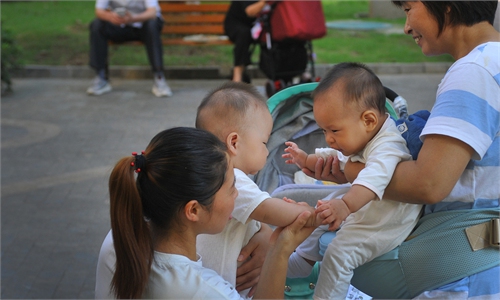More places in China expected to offer financial support to assisted reproduction technologies; various measures needed to encourage childbirth

Photo: VCG
It was 11:30 am, the second floor of the Peking University Third Hospital Reproductive Center in Beijing was still full of people with many women waiting outside doctors' consulting rooms or lining up for electrocardiographic or other necessary examinations before starting the in-vitro fertilization (IVF) cycle or chatting with each other on the IVF treatment. Recently, many have talked about a new topic - how much of the costs for IVF and related assisted reproduction technologies can be covered by the healthcare system in the place where they came from.
Starting from July 1, Beijing began to implement a new policy - 16 types of assisted reproduction technologies, including commonly used ovulation induction test, sperm optimal treatment, semen cryopreservation, in-vitro fertilization embryo culture, embryo transplantation and frozen embryos recovery, will be included into basic health insurance.
The policy has helped reduce around 30 percent to 50 percent of expanses on assisted reproduction technologies and many couples have chose to come to Beijing which is among the cities that own the best medical resources in the country, the Global Times has learned.
The number of patients has increased more than one third since the implementation of the policy at the beginning of July, with many coming from outside Beijing. Patients have to register two weeks to one month in advance to book an appointment to consult with some celebrated doctors, a working staff from the Reproductive Center told the Global Times.
All the self-service machines in the center have been updated with an option of a medical insurance payment without a complicated process, but an reimbursement upper limit varies with different policies in different places.
Meng Zi (pseudonym) who lives in Beijing, felt lucky to become the first batch of patients in Beijing to get her fees for IVF embryo transferring covered by the medical insurance.
"I did the embryo transfer on June 30 and had other embryo frozen for next transferring, which cost 5,314 yuan ($737) in total, but I only need to pay for 1,976 yuan of them as the medical insurance covered most of the fees," said Meng Zi, noting that she felt relieved financially as she may need to receive more than one embryo transferring to successfully become pregnant.
But not all couples' financial burdens have been relieved. A couple from Shanxi Province told the Global Times that they have spent more than 100,000 yuan for various examinations and a single IVF cycle: defined as ovarian stimulation, egg retrieval and embryo transfer as well as the preimplantation genetic screening (PGS) and yet failed.
"Shanxi Province has not included the assisted reproduction technologies into the basic insurance, which means we need to pay all the fees to have another IVF-cycle. Moreover, our accommodation in Beijing and travelling expense from Shanxi to Beijing are also burdens as it usually costs more than a month for a single cycle," said the husband, surnamed Wang.
After hearing the news of Beijing's new policy, Wang left a message on the "Board for Leaders" - a webpage that solicits advices from the public to provincial leaders in the Shanxi Province, suggesting the province to include assisted reproduction technologies in medical insurance as soon as possible.
"I have seen similar advices from different places in the province in the board, noting that the government is encouraging residents to have more babies and it should also help to relieve the financial burden for couples who is willing to have a baby, but faces problems in conceiving," said Wang.
Aside from Beijing, many places in China have announced boosting financial support for couples who need assisted reproduction technologies. For example, Northeast China's Liaoning Province announced in May that 18 assisted reproduction technologies would be covered by the local healthcare system from July 1.
As early as in August 2022, a total of 17 Chinese government departments had jointly released a guideline on support policies in finance, tax, housing, employment, education, and other fields to create a childbearing-friendly society and encourage families to have more children, advising provinces and regions to consider covering related technologies as part of local healthcare systems based on available capacity.

Photo: VCG
More efforts need for fertility-friendly society
He Yafu, an independent demographer, told the Global Times that China is facing increasing demands for assisted reproduction technologies in recent years due to the relaxing of birth policies and the increase of infertility rate.
The latest data on national reproductive health showed that the incidence of infertility from 2007 to 2020 has increased from 12 percent to 18 percent.
And in 2025, the number of patients for infertility would be 60 million, according to a report of China Science Daily.
China has witnessed rapid developments on assisted reproduction technologies in recent years with the annual number of children born under the help of related technologies now exceeding 300,000 every year, accounting for 3 percent of the total number of newborns, according to a research report released by Beijing-based YuWa Population Research Institute.
But owing to unbalanced medical resources in different regions, high prices and imperfected policies have hindered the full release of needs on assisted reproduction technologies, said the report.
For example, the lowest averaged price for a full IVF cycle is around 30,000 yuan to 50,000 yuan and if the success rate is about 40 percent to 50 percent, a couple needs to have two to three cycles to succeed in conceiving. The cost would be higher for having the PGS. The total cost would be 60,000 to 150,000 yuan, which exceed the affordability of 60 percent of families in China, according to the report.
How could financial support on assisted technologies help increase birth rate? Data released in the YuWa Population Research Institute report showed that the number of newborns could be increased by 151,000, 302,000 and 453,000 in 2030 in China if the governments offer 20 percent, 50 percent and 80 percent of subsidies for a single cycle respectively.
Against the backdrop of China's declining birth rate, to include the related technologies into medical insurance is a significant policy to encourage childbirth and more places in China are expected to take similar measures like Beijing. But more efforts need to stimulate the willingness of having children, especially on decreasing the cost for childbearing, said He.
More experts in China are calling for stronger policies to create a childbearing-friendly society to encourage childbirth, such as financial support for couples who choose to have more than one child. Many places in China have announced policies to encourage families to raise more than one child, including prolonged maternity leave, increased maternity allowances, and support for home purchases.


